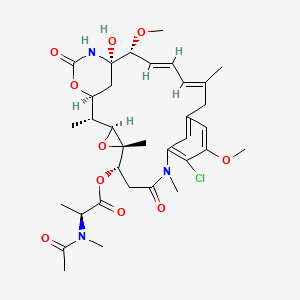| Montemurro F |
Trastuzumab emtansine in HER2-positive metastatic breast cancer. |
2017 |
Lancet Oncol. |
pmid:28526537
|
| Li C et al. |
A Phase I Pharmacokinetic Study of Trastuzumab Emtansine (T-DM1) in Patients with Human Epidermal Growth Factor Receptor 2-Positive Metastatic Breast Cancer and Normal or Reduced Hepatic Function. |
2017 |
Clin Pharmacokinet |
pmid:27995530
|
| Takegawa N et al. |
DS-8201a, a new HER2-targeting antibody-drug conjugate incorporating a novel DNA topoisomerase I inhibitor, overcomes HER2-positive gastric cancer T-DM1 resistance. |
2017 |
Int. J. Cancer |
pmid:28677116
|
| Mescher C et al. |
Left Ventricular Ejection Fraction Screening and Clinical Decision-making in Metastatic HER2-positive Breast Cancer. |
2017 |
Anticancer Res. |
pmid:28668870
|
| Kmietowicz Z |
NICE approves trastuzumab emtansine after deal with drug company. |
2017 |
BMJ |
pmid:28623237
|
| Krop IE et al. |
Trastuzumab emtansine versus treatment of physician's choice in patients with previously treated HER2-positive metastatic breast cancer (TH3RESA): final overall survival results from a randomised open-label phase 3 trial. |
2017 |
Lancet Oncol. |
pmid:28526538
|
| Diéras V et al. |
Trastuzumab emtansine versus capecitabine plus lapatinib in patients with previously treated HER2-positive advanced breast cancer (EMILIA): a descriptive analysis of final overall survival results from a randomised, open-label, phase 3 trial. |
2017 |
Lancet Oncol. |
pmid:28526536
|
| Morimura O et al. |
Trastuzumab emtansine suppresses the growth of HER2-positive small-cell lung cancer in preclinical models. |
2017 |
Biochem. Biophys. Res. Commun. |
pmid:28526406
|
| Menderes G et al. |
SYD985, a novel duocarmycin-based HER2-targeting antibody-drug conjugate, shows promising antitumor activity in epithelial ovarian carcinoma with HER2/Neu expression. |
2017 |
Gynecol. Oncol. |
pmid:28473206
|
| Moore KN et al. |
Phase 1 dose-escalation study of mirvetuximab soravtansine (IMGN853), a folate receptor α-targeting antibody-drug conjugate, in patients with solid tumors. |
2017 |
Cancer |
pmid:28440955
|
| Ito K et al. |
Near-Infrared Photochemoimmunotherapy by Photoactivatable Bifunctional Antibody-Drug Conjugates Targeting Human Epidermal Growth Factor Receptor 2 Positive Cancer. |
2017 |
Bioconjug. Chem. |
pmid:28402624
|
| Sun X et al. |
Effects of Drug-Antibody Ratio on Pharmacokinetics, Biodistribution, Efficacy, and Tolerability of Antibody-Maytansinoid Conjugates. |
2017 |
Bioconjug. Chem. |
pmid:28388844
|
| Zhong P et al. |
αβ integrin-targeted micellar mertansine prodrug effectively inhibits triple-negative breast cancer in vivo. |
2017 |
Int J Nanomedicine |
pmid:29138558
|
| Li Y et al. |
EpCAM aptamer-functionalized polydopamine-coated mesoporous silica nanoparticles loaded with DM1 for targeted therapy in colorectal cancer. |
2017 |
Int J Nanomedicine |
pmid:28894364
|
| Chen SC et al. |
Population pharmacokinetics and exposure-response of trastuzumab emtansine in advanced breast cancer previously treated with ≥2 HER2-targeted regimens. |
2017 |
Br J Clin Pharmacol |
pmid:28733983
|
| Iwamoto N et al. |
LC-MS bioanalysis of Trastuzumab and released emtansine using nano-surface and molecular-orientation limited (nSMOL) proteolysis and liquid-liquid partition in plasma of Trastuzumab emtansine-treated breast cancer patients. |
2017 |
J Pharm Biomed Anal |
pmid:28648785
|
| Seidel K et al. |
Synthesis of Magnetic-Nanoparticle/Ansamitocin Conjugates-Inductive Heating Leads to Decreased Cell Proliferation In Vitro and Attenuation Of Tumour Growth In Vivo. |
2017 |
Chemistry |
pmid:28585348
|
| Lynce F et al. |
SAFE-HEaRt: Rationale and Design of a Pilot Study Investigating Cardiac Safety of HER2 Targeted Therapy in Patients with HER2-Positive Breast Cancer and Reduced Left Ventricular Function. |
2017 |
Oncologist |
pmid:28314836
|
| Janjigian YY and Braghiroli MI |
Current Progress in Human Epidermal Growth Factor Receptor 2 Targeted Therapies in Esophagogastric Cancer. |
2017 |
Surg. Oncol. Clin. N. Am. |
pmid:28279471
|
| Stefan N et al. |
Highly Potent, Anthracycline-based Antibody-Drug Conjugates Generated by Enzymatic, Site-specific Conjugation. |
2017 |
Mol. Cancer Ther. |
pmid:28258164
|
